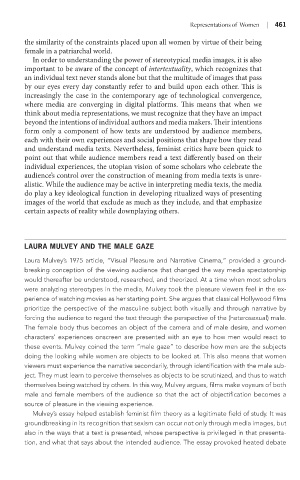Page 482 - Battleground The Media Volume 1 and 2
P. 482
Representat ons of Women | 1
the similarity of the constraints placed upon all women by virtue of their being
female in a patriarchal world.
In order to understanding the power of stereotypical media images, it is also
important to be aware of the concept of intertextuality, which recognizes that
an individual text never stands alone but that the multitude of images that pass
by our eyes every day constantly refer to and build upon each other. This is
increasingly the case in the contemporary age of technological convergence,
where media are converging in digital platforms. This means that when we
think about media representations, we must recognize that they have an impact
beyond the intentions of individual authors and media makers. Their intentions
form only a component of how texts are understood by audience members,
each with their own experiences and social positions that shape how they read
and understand media texts. Nevertheless, feminist critics have been quick to
point out that while audience members read a text differently based on their
individual experiences, the utopian vision of some scholars who celebrate the
audience’s control over the construction of meaning from media texts is unre-
alistic. While the audience may be active in interpreting media texts, the media
do play a key ideological function in developing ritualized ways of presenting
images of the world that exclude as much as they include, and that emphasize
certain aspects of reality while downplaying others.
laura MulVey and the Male gaze
Laura Mulvey’s 1975 article, “Visual Pleasure and Narrative Cinema,” provided a ground-
breaking conception of the viewing audience that changed the way media spectatorship
would thereafter be understood, researched, and theorized. At a time when most scholars
were analyzing stereotypes in the media, Mulvey took the pleasure viewers feel in the ex-
perience of watching movies as her starting point. She argues that classical Hollywood films
prioritize the perspective of the masculine subject both visually and through narrative by
forcing the audience to regard the text through the perspective of the (heterosexual) male.
The female body thus becomes an object of the camera and of male desire, and women
characters’ experiences onscreen are presented with an eye to how men would react to
these events. Mulvey coined the term “male gaze” to describe how men are the subjects
doing the looking while women are objects to be looked at. This also means that women
viewers must experience the narrative secondarily, through identification with the male sub-
ject. They must learn to perceive themselves as objects to be scrutinized, and thus to watch
themselves being watched by others. In this way, Mulvey argues, films make voyeurs of both
male and female members of the audience so that the act of objectification becomes a
source of pleasure in the viewing experience.
Mulvey’s essay helped establish feminist film theory as a legitimate field of study. It was
groundbreaking in its recognition that sexism can occur not only through media images, but
also in the ways that a text is presented, whose perspective is privileged in that presenta-
tion, and what that says about the intended audience. The essay provoked heated debate

